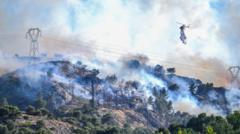In a startling development, scientists reported that the concentration of carbon dioxide (CO2) in the atmosphere reached an all-time high in 2024, surpassing previous benchmarks and jeopardizing international climate commitments. Factors such as aggressive fossil fuel consumption and adverse natural conditions have impeded the Earth’s ability to absorb CO2, leading to a concerning increase in greenhouse gases.
Record Surge in Carbon Dioxide Levels Threatens Global Climate Goals

Record Surge in Carbon Dioxide Levels Threatens Global Climate Goals
Levels of carbon dioxide, a major contributor to global warming, rose significantly in 2024, catalyzed by unprecedented fossil fuel emissions and environmental factors.
The concentrations of CO2 have surged to over 50% higher than pre-industrial levels, marking an alarming trend that is incompatible with the global objective of limiting temperature rise to 1.5C above pre-industrial levels, as established during the historic Paris Agreement of 2015. Reports confirmed that 2024 was the hottest year recorded to date, with average annual temperatures climbing above this critical threshold for the first time.
The dramatic biological and climatic transformations witnessed—attributed in part to record-high fossil fuel emissions, extensive wildfires, and debilitating drought conditions—have resulted in a staggering escalation of atmospheric CO2. Richard Betts from the Met Office highlighted that the current trajectory of CO2 emissions stands in stark contradiction to the goal of slowing global warming.
The long-term rise in CO2 levels has been recognized as primarily human-driven, arising chiefly from the extensive burning of coal, oil, and gas, as well as deforestation. Paleoclimate records suggest that CO2 concentrations in the atmosphere are at their peak in at least two million years, but varied yearly emissions from human activity and natural carbon sink capacity influence this rising trend.
In 2024 alone, CO2 levels jumped nearly 3.6 parts per million, achieving an alarming record high of over 424 ppm. This increase was the largest since systematic atmospheric measurements began at Mauna Loa, Hawaii, in 1958. Experts anticipate that despite a potentially milder rise in CO2 in 2025 due to shifting conditions, the ongoing accumulation poses a significant threat to established climate targets.
The degradation of notable carbon sinks, such as the Amazon rainforest and Arctic tundra, indicates that the planet’s ability to offset emissions is diminishing. Experts are closely monitoring these ecosystems to gauge their future contributions to carbon absorption.
While scientists acknowledge a temporary dip in global temperatures with the transition to La Niña conditions, the longer-term implications of soaring CO2 levels remain grave, with expectations of renewed warming in the absence of significant reductions in greenhouse gas emissions.
With the rise of climate challenges intensifying, urgent action is paramount to adhere to the critical thresholds established by climate scientists worldwide.
The dramatic biological and climatic transformations witnessed—attributed in part to record-high fossil fuel emissions, extensive wildfires, and debilitating drought conditions—have resulted in a staggering escalation of atmospheric CO2. Richard Betts from the Met Office highlighted that the current trajectory of CO2 emissions stands in stark contradiction to the goal of slowing global warming.
The long-term rise in CO2 levels has been recognized as primarily human-driven, arising chiefly from the extensive burning of coal, oil, and gas, as well as deforestation. Paleoclimate records suggest that CO2 concentrations in the atmosphere are at their peak in at least two million years, but varied yearly emissions from human activity and natural carbon sink capacity influence this rising trend.
In 2024 alone, CO2 levels jumped nearly 3.6 parts per million, achieving an alarming record high of over 424 ppm. This increase was the largest since systematic atmospheric measurements began at Mauna Loa, Hawaii, in 1958. Experts anticipate that despite a potentially milder rise in CO2 in 2025 due to shifting conditions, the ongoing accumulation poses a significant threat to established climate targets.
The degradation of notable carbon sinks, such as the Amazon rainforest and Arctic tundra, indicates that the planet’s ability to offset emissions is diminishing. Experts are closely monitoring these ecosystems to gauge their future contributions to carbon absorption.
While scientists acknowledge a temporary dip in global temperatures with the transition to La Niña conditions, the longer-term implications of soaring CO2 levels remain grave, with expectations of renewed warming in the absence of significant reductions in greenhouse gas emissions.
With the rise of climate challenges intensifying, urgent action is paramount to adhere to the critical thresholds established by climate scientists worldwide.



















